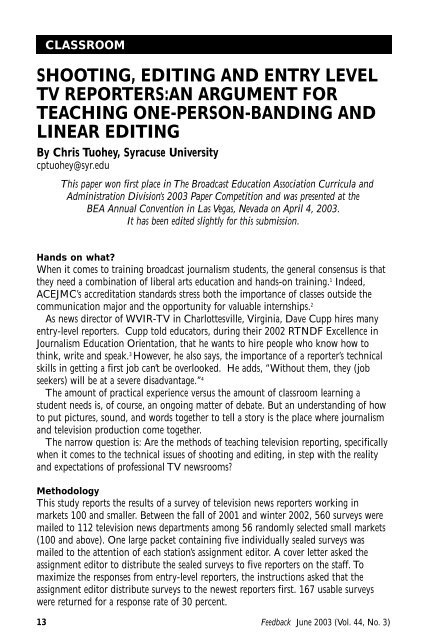JUNEFeedback
Issue 3 - Broadcast Education Association
Issue 3 - Broadcast Education Association
You also want an ePaper? Increase the reach of your titles
YUMPU automatically turns print PDFs into web optimized ePapers that Google loves.
CLASSROOMSHOOTING, EDITING AND ENTRY LEVELTV REPORTERS:AN ARGUMENT FORTEACHING ONE-PERSON-BANDING ANDLINEAR EDITINGBy Chris Tuohey, Syracuse Universitycptuohey@syr.eduThis paper won first place in The Broadcast Education Association Curricula andAdministration Division’s 2003 Paper Competition and was presented at theBEA Annual Convention in Las Vegas, Nevada on April 4, 2003.It has been edited slightly for this submission.Hands on what?When it comes to training broadcast journalism students, the general consensus is thatthey need a combination of liberal arts education and hands-on training. 1 Indeed,ACEJMC’s accreditation standards stress both the importance of classes outside thecommunication major and the opportunity for valuable internships. 2As news director of WVIR-TV in Charlottesville, Virginia, Dave Cupp hires manyentry-level reporters. Cupp told educators, during their 2002 RTNDF Excellence inJournalism Education Orientation, that he wants to hire people who know how tothink, write and speak. 3 However, he also says, the importance of a reporter’s technicalskills in getting a first job can’t be overlooked. He adds, “Without them, they (jobseekers) will be at a severe disadvantage.” 4The amount of practical experience versus the amount of classroom learning astudent needs is, of course, an ongoing matter of debate. But an understanding of howto put pictures, sound, and words together to tell a story is the place where journalismand television production come together.The narrow question is: Are the methods of teaching television reporting, specificallywhen it comes to the technical issues of shooting and editing, in step with the realityand expectations of professional TV newsrooms?MethodologyThis study reports the results of a survey of television news reporters working inmarkets 100 and smaller. Between the fall of 2001 and winter 2002, 560 surveys weremailed to 112 television news departments among 56 randomly selected small markets(100 and above). One large packet containing five individually sealed surveys wasmailed to the attention of each station’s assignment editor. A cover letter asked theassignment editor to distribute the sealed surveys to five reporters on the staff. Tomaximize the responses from entry-level reporters, the instructions asked that theassignment editor distribute surveys to the newest reporters first. 167 usable surveyswere returned for a response rate of 30 percent.13Feedback June 2003 (Vol. 44, No. 3)
















